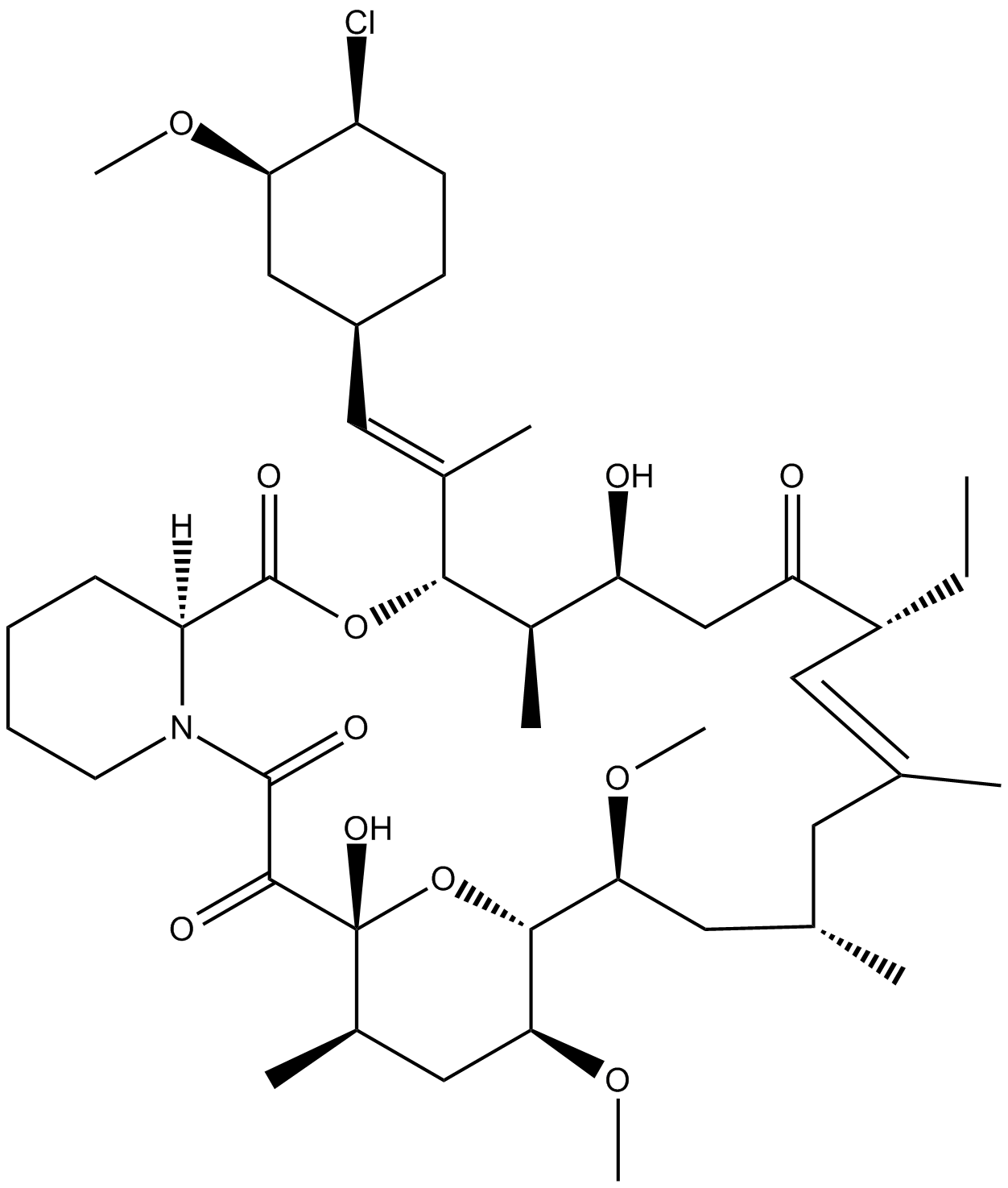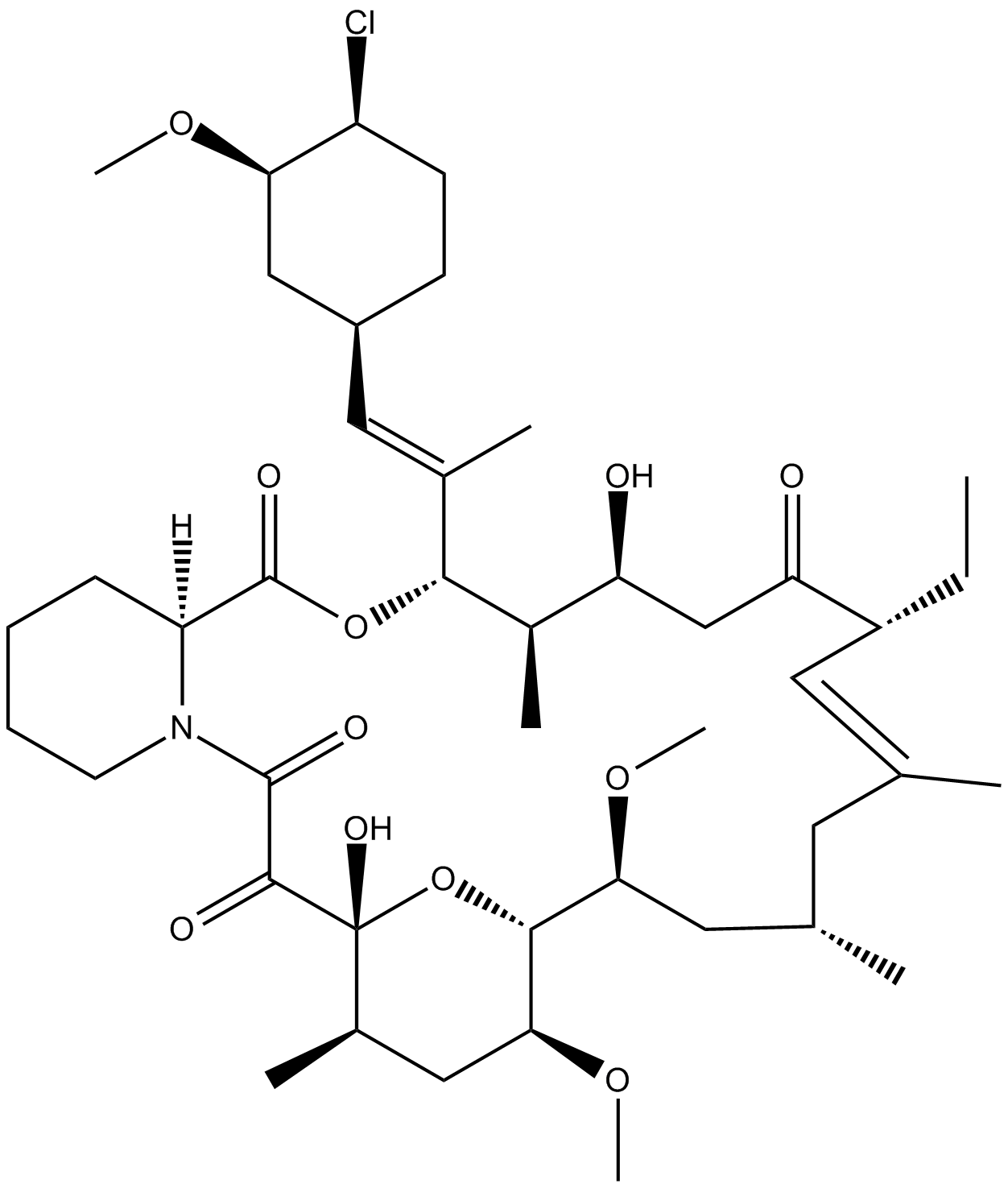Pimecrolimus
Pimecrolimus is a cell-selective inhibitor of inflammatory cytokines secretion in T cells and mast cells [1].
Inflammatory cytokines are cytokines which promote systemic inflammation. Pimecrolimus can be used for the treatment of inflammatory skin diseases, such as plaque-type psoriasis, atopic dermatitis, irritant contact dermatitis and allergic contact dermatitis [1].
Pimecrolimus is a cell-selective inflammatory cytokines secretion inhibitor. Pimecrolimus inhibited the secretion of inflammatory cytokines in mast cells and T cells and also inhibited the release of preformed inflammatory mediators from mast cells. Pimecrolimus exhibited a low potential to impair systemic immune reactions in the skin [1]. In peripheral blood leukocytes contained basophil or mast cells, pimecrolimus inhibited histamine release induced by anti-IgE from basophils and mast cells by 82% and 73%, respectively. Also, pimecrolimus inhibited tryptase, LTC4 and TNF-alpha release [2]. In CD4+ T cells stimulated by dendritic cells (DC), pimecrolimus inhibited the up-regulation of CD25 and CD54 and surface expression of OX40. Pimecrolimus inhibited T cell proliferation with IC50 value of 0.55 nM and inhibited the synthesis of IFN-γ and TNF-α [3].
In treatment of allergic contact dermatitis (ACD) mice and rats, pimecrolimus exhibited a higher potency. In atopic dermatitis rats, pimecrolimus effectively reduced pruritus and skin inflammation [1].
References:
[1]. Stuetz A, Grassberger M, Meingassner JG. Pimecrolimus (Elidel, SDZ ASM 981)--preclinical pharmacologic profile and skin selectivity. Semin Cutan Med Surg, 2001, 20(4): 233-241.
[2]. Zuberbier T, Chong SU, Grunow K, et al. The ascomycin macrolactam pimecrolimus (Elidel, SDZ ASM 981) is a potent inhibitor of mediator release from human dermal mast cells and peripheral blood basophils. J Allergy Clin Immunol, 2001, 108(2): 275-280.
[3]. Kalthoff FS, Chung J, Stuetz A. Pimecrolimus inhibits up-regulation of OX40 and synthesis of inflammatory cytokines upon secondary T cell activation by allogeneic dendritic cells. Clin Exp Immunol, 2002, 130(1): 85-92.
| Physical Appearance | A solid |
| Storage | Store at -20°C |
| M.Wt | 810.45 |
| Cas No. | 137071-32-0 |
| Formula | C43H68ClNO11 |
| Solubility | ≥32.05 mg/mL in DMSO; insoluble in H2O; ≥2.12 mg/mL in EtOH with gentle warming and ultrasonic |
| SDF | Download SDF |
| Canonical SMILES | O=C([C@@](CCCC1)([H])N1C(C([C@@]2(O)[C@H](C)C[C@H](OC)[C@@](O2)([H])[C@@H](OC)C[C@@H](C)C/C(C)=C/[C@H]3CC)=O)=O)O[C@H](/C(C)=C/[C@H]4C[C@@H](OC)[C@@H](Cl)CC4)[C@H](C)[C@@H](O)CC3=O |
| Shipping Condition | Small Molecules with Blue Ice, Modified Nucleotides with Dry Ice. |
| General tips | We do not recommend long-term storage for the solution, please use it up soon. |
Quality Control & MSDS
- View current batch:
Chemical structure









